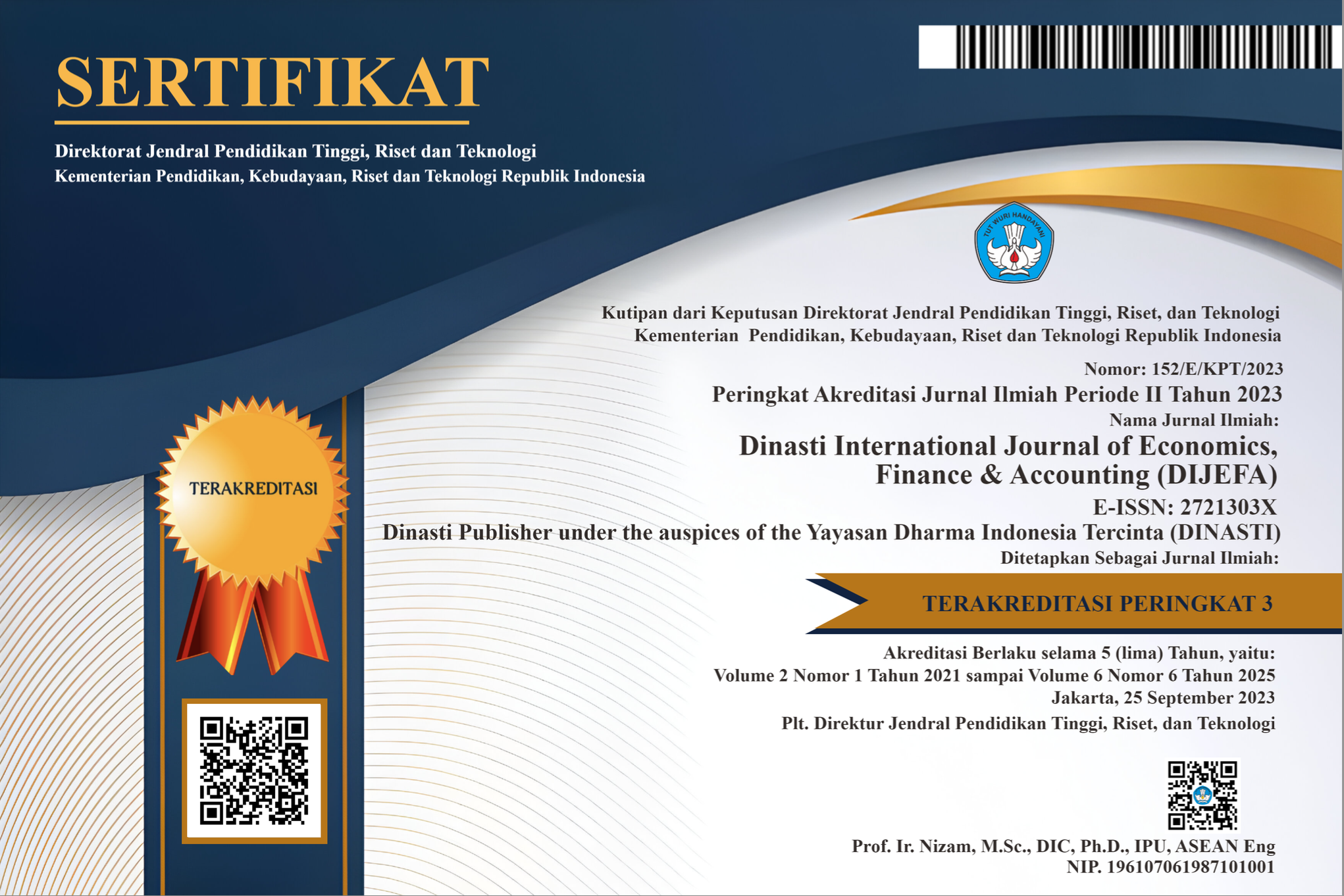The Influence of Work Facilities and Internal Communication on the Performance of Civil Servants Through Motivation at the Education Office and Culture of Muaro Jambi Regency
DOI:
https://doi.org/10.38035/dijefa.v5i4.3269Keywords:
Work Facilities, Internal Communication, Work Motivation, Employee PerformanceAbstract
This study evaluates and analyzes the impact of work facilities and internal communication on civil servant performance, with work motivation as a mediating variable, at the Education and Culture Office of Muaro Jambi Regency. Using both descriptive and verification methods, the research involved 62 employees from the office and employed the Partial Least Squares (PLS) method for analysis. The results from the questionnaire indicated that work facilities had a total score of 2859, classified as good, while internal communication scored 2836, also in the good range. Work motivation was rated at 3080, placing it in the high category, and employee performance scored 3099, which is similarly high. The findings show that work facilities have significant impact on motivation. Internal communication also positively and significantly influences motivation. Additionally, both work facilities and internal communication have significant effect on employee performance. Motivation is demonstrated to positively and significantly affect employee performance. Moreover, work facilities and internal communication both positively and significantly impact employee performance through the mediation of motivation at the Muaro Jambi Regency Education and Culture Office.
References
Abbas, S. A., & Fadhillah, P. (2024). Economics and Digital Business Review Pengaruh Komunikasi , Motivasi dan Lingkungan Kerja Terhadap Kinerja Karyawan. 5(1), 284–294.
Arita, S., & Agustin, F. (2022). Pengaruh Fasilitas Kerja Dan Beban Kerja Terhadap Motivasi Kerja Pegawai. EcoGen, 5(4), 544–554. http://ejournal.unp.ac.id/students/index.php/pek/index
Jufrizen, & Hadi, F. P. (2021). Pengaruh Fasilitas Kerja dan Disiplin Kerja Terhadap Kinerja Karyawan Melalui Motivasi Kerja. Jurnal Sains Manajemen, 7(1).
Kasmir. (2016). Manajemen Sumber Daya Manusia (Teori dan Praktik). Jakarta: PT Raja Grafindo Persada.
Mathis, R. L., & Jackson. (2012). Manajemen Sumber Daya Manusia, Edisi Pertama. Salemba Empat.
Mijaya, R., & Susanti, F. (2023). Pengaruh Stres Kerja, Komunikasi Internal Dan Lingkungan Kerja Terhadap Kinerja Pegawai Pada Badan Kepegawaian Dan Pengembangan Sumber Daya Manusia (Bkpsdm) Kabupaten Agam. Jurnal Economina, 2(2), 562–573. https://doi.org/10.55681/economina.v2i2.336
Moenir. (2014). Manajemen Pelayanan Umum Di Indonesia. Bumi Aksara.
Sari, I. (2023). Pengaruh Komunikasi Internal terhadap Motivasi Kerja Pegawai. Jurnal Administrasi Pendidikan, 23(1), 91–97. https://doi.org/10.53008/kalbisocio.v10i1.1805
Sudirman, Hapsara, O., & Zahari. (2020). Metode Penelitian Kuantitatif. Magnum Pustaka Utama.
Sugiyono. (2016). Metode Penelitian Kuantitatif, Kualitatif, dan R&D. Bandung?: ALFABETA.
Wibowo. (2016). Prilaku Dalam Organisasi. Rajawali Pers.
Zahari, M., Akbar, A., & Syaifullah, S. (2023). The Influence of Motivation and Work Facilities on Organizational Commitment and its Impact on the Employee Performance at Dinas Perindustrian dan Perdagangan Provinsi Jambi. 4(6), 1117–1125.
Zahari, M., Sujatmiko, W., Kembauw, E., Tabun, M. A., & Ihwanudin, N. (2022). Manajamen SDM (Strategi Organisasi Bisnis Modern). Seval Literindo Kreasi
Downloads
Published
How to Cite
Issue
Section
License
Copyright (c) 2024 Jasrianto Jasrianto, M. Zahari, Osrita Hapsara

This work is licensed under a Creative Commons Attribution 4.0 International License.
Authors who publish their manuscripts in this journal agree to the following conditions:
- The copyright on each article belongs to the author(s).
- The author acknowledges that the Dinasti International Journal of Economics, Finance & Accounting (DIJEFA) has the right to be the first to publish with a Creative Commons Attribution 4.0 International license (Attribution 4.0 International (CC BY 4.0).
- Authors can submit articles separately, arrange for the non-exclusive distribution of manuscripts that have been published in this journal into other versions (e.g., sent to the author's institutional repository, publication into books, etc.), by acknowledging that the manuscript has been published for the first time in the Dinasti International Journal of Economics, Finance & Accounting (DIJEFA).


























































